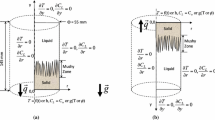Abstract
Macrosegregation as a consequence of solidification of a binary Pb–48 wt% Sn alloy in two-dimensional rectangle cavity was investigated by two-phase model instead of the common used continuum model. The macroscopic transport of mass, momentum, species and energy was coupled with the microscopic descriptions of grain nucleation and growth. The mathematic equations of the two-phase model were discretized on staggered grids and solved by the finite volume method. The final tin concentrations along different heights over the bottom face were compared with the experiment measurements. Simulations with different microstructure parameters (second dendrite arm spacing (SDAS)) were conducted to ascertain the influence of microstructure on the final macrosegregation. The results show that with the decrease in SDAS value, the drag force as the resistance to relative motion between solid and liquid phase increases, and the macrosegregation during solidification is alleviated.










Similar content being viewed by others
References
Beckermann C. Modelling of macrosegregation: applications and future needs. Int Mater Rev. 2002;47(5):243.
Flemings MC, Nereo GE. Macrosegregation: part I. Trans Metall Soc AIME. 1967;239(9):1449.
Beckermann C, Viskanta R. Double-diffusive convection during dendritic solidification of a binary mixture. Physicochem Hydrodyn. 1988;10(2):195.
Bennon WD, Incropera FP. A continuum model for momentum, heat and species transport in binary solid–liquid phase change systems—I. Model formulation. Int J Heat Mass Transf. 1987;30(10):2161.
Ni J, Beckermann C. A volume-averaged two-phase model for transport phenomena during solidification. Metall Trans B. 1991;22(3):349.
Wu M, Fjeld A, Ludwig A. Modelling mixed columnar-equiaxed solidification with melt convection and grain sedimentation—part I: model description. Comput Mater Sci. 2010;50(1):32.
Wang CY, Beckermann C. Equiaxed dendritic solidification with convection: part I. Multiscale/multiphase modeling. Metall and Mater Trans A. 1996;27(9):2754.
Wu MH, Ludwig A. A three-phase model for mixed columnar-equiaxed solidification. Metall Mater TransA. 2006;37(5):1613.
Li W, Shen H, Liu B. Numerical simulation of macrosegregation in steel ingots using a two-phase model. Int J Miner Metal Mater. 2012;19(9):787.
Tu W, Shen H, Liu B. Two-phase modeling of macrosegregation in a 231t steel ingot. ISIJ Int. 2014;54(2):351.
Wan DC, Patnaik BSV, Wei GW. A new benchmark quality solution for the buoyancy-driven cavity by discrete singular convolution. Numer Heat Transf B. 2001;40(3):199.
Hebditch DJ, Hunt JD. Observations of ingot macrosegregation on model systems. Metall Mater Trans B. 1974;5(7):1557.
Gidaspow D. Multiphase Flow and Fluidization: Continuum and Kinetic Theory Descriptions. London: Academic Press; 1994. 73.
Patankar SV. Numerical Heat Transfer and Fluid Flow. Washington: Hemisphere; 1980. 126.
Jones IP. A comparison problem for numerical methods in fluid dynamics: the double glazing problem. In: Numerical Methods in Fluids in Thermal Problems: Proceedings of the First International Conference. Swansea: Pineridge; 1979. 338.
Christensen ER. Numerical solution of buoyancy-driven flow problems. Trondheim: Norwegian University of Science and Technology; 2009. 34.
Ahmad N, Combeau H, Desbiolles JL, Jalanti T, Lesoult G, Rappaz J, Rappaz M, Stomp C. Numerical simulation of macrosegregation: a comparison between finite volume method and finite element method predictions and a confrontation with experiments. Metall Mater Trans A. 1998;29(2):617.
Schneider MC, Beckermann C. Formation of macrosegregation by multicomponent thermosolutal convection during the solidification of steel. Metall Mater Trans A. 1995;26(9):2373.
Acknowledgments
This study was financially supported by the National Basic Research Program of China (No. 2011CB012900) and the Tsinghua University Initiative Scientific Research Program (No. 2012THZ01013).
Author information
Authors and Affiliations
Corresponding author
Rights and permissions
About this article
Cite this article
Tu, WT., Shen, HF. & Liu, BC. Numerical simulation of macrosegregation during solidification of binary alloys. Rare Met. 35, 591–597 (2016). https://doi.org/10.1007/s12598-015-0458-9
Received:
Revised:
Accepted:
Published:
Issue Date:
DOI: https://doi.org/10.1007/s12598-015-0458-9




